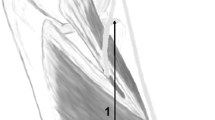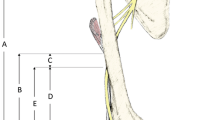Abstract
Purpose
The aim of this study was to provide guidance on the safe zones for the exposure of the proximal radius by measuring the distance from the PIN to various anatomical landmarks in the proximal forearm in pronation and supination.
Methods
Twenty cadaveric arms were used for this study. On the anterior aspect of the forearm, the distance between insertion of the biceps tendon and the arcade of Frohse as well as the shortest distance between the PIN and the ulnar aspect of the radial neck were measured. On the posterior aspect of the forearm, the shortest distance between the PIN and the ulnar border of the interosseous membrane was measured at 30 and 50 mm distal to the articular surface of the radial head.
Results
The distance between the PIN and ulnar aspect of the radial neck had a mean of 21.6 mm in supination and 13.3 mm in pronation. The distance between the radial tuberosity and the arcade of Frohse was 18.6 mm. The mean distance between the PIN and the radial border of ulna at 30 mm distal to the articular surface of the proximal radius was 12.3 mm in supination and 22.3 mm in pronation. At 50 mm distal to the articular surface of the proximal radius the mean distance was 8 mm in supination and 16.2 mm in pronation.
Conclusions
The course of this nerve is variable as it winds around the radial neck within the belly of the supinator muscle. Safe distances for dissection have been presented in our study.



Similar content being viewed by others
References
Ay S, Apaydin N, Acar H, Akinci M, Piskin A, Tekdemir I, Elhan A (2005) Anatomic pattern of the terminal branches of posterior interosseous nerve. Clin Anat 18:290–295
Bauer G, Arand M, Mutschler W (1991) Post-traumatic radioulnar synostosis after forearm fracture osteosynthesis. Arch Orthop Trauma Surg 110:142–145
Birch R, Bonney G, Dowell J, Hollingdale J (1991) Iatrogenic injuries of peripheral nerves. J Bone Joint Surg Br 73:280–282
Boyd H (1940) Surgical exposure of the ulna and proximal third of the radius in one incision. Surg Gynecol Obstet 71:87–88
Diliberti T, Botte MJ, Abrams RA (2000) Anatomical considerations regarding the posterior interosseous nerve during posterolateral approaches to the proximal part of the radius. J Bone Joint Surg Am 82:809–813
Duquin TR, Chavan PR, Bisson LJ (2010) Innervation of the supinator muscle and its relationship to two-incision distal biceps tendon repair: an anatomic study. Clin Anat 23:413–419
Hoppenfeld S, DeBoer P (2003) Surgical exposures in orthopaedics: the anatomic approach, 3rd edn. Lippincott Williams & Wilkins, Philadelphia, pp 143–171
Kaplan E (1941) Surgical approach to the proximal end of radius and its use in fractures of the head and neck of the radius. J Bone Joint Surg Am 23:86–92
Mekhail AO, Ebraheim NA, Jackson WT, Yeasting RA (1995) Vulnerability of the posterior interosseous nerve during proximal radius exposures. Clin Orthop Relat Res 315:199–208
Mekhail AO, Ebraheim NA, Jackson WT, Yeasting RA (1996) Anatomic considerations for the anterior exposure of the proximal portion of the radius. J Hand Surg Am 21:794–801
Spinner M (1968) The arcade of Frohse and its relationship to posterior interosseous nerve paralysis. J Bone Joint Surg Br 50:809–812
Strachan JC, Ellis BW (1971) Vulnerability of the posterior interosseous nerve during radial head resection. J Bone Joint Surg Br 53:320–323
Thiel W (1992) The preservation of the whole corpse with natural color. Ann Anat 174:185–195
Witt JD, Kamineni S (1998) The posterior interosseous nerve and the posterolateral approach to the proximal radius. J Bone Joint Surg Br 80:240–242
Conflict of interest
The authors declare that they have no conflict of interest.
Author information
Authors and Affiliations
Corresponding author
Rights and permissions
About this article
Cite this article
Heidari, N., Kraus, T., Weinberg, A.M. et al. The risk injury to the posterior interosseous nerve in standard approaches to the proximal radius: a cadaver study. Surg Radiol Anat 33, 353–357 (2011). https://doi.org/10.1007/s00276-010-0718-1
Received:
Accepted:
Published:
Issue Date:
DOI: https://doi.org/10.1007/s00276-010-0718-1




